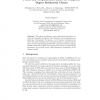Free Online Productivity Tools
i2Speak
i2Symbol
i2OCR
iTex2Img
iWeb2Print
iWeb2Shot
i2Type
iPdf2Split
iPdf2Merge
i2Bopomofo
i2Arabic
i2Style
i2Image
i2PDF
iLatex2Rtf
Sci2ools
EUROCRYPT
1999
Springer
1999
Springer
Public-Key Cryptosystems Based on Composite Degree Residuosity Classes
Abstract. This paper investigates a novel computational problem, namely the Composite Residuosity Class Problem, and its applications to public-key cryptography. We propose a new trapdoor mechanism and derive from this technique three encryption schemes: a trapdoor permutation and two homomorphic probabilistic encryption schemes computationally comparable to RSA. Our cryptosystems, based on usual modular arithmetics, are provably secure under appropriate assumptions in the standard model. 1 Background Since the discovery of public-key cryptography by Diffie and Hellman [5], very few convincingly secure asymetric schemes have been discovered despite considerable research efforts. We refer the reader to [26] for a thorough survey of existing public-key cryptosystems. Basically, two major species of trapdoor techniques are in use today. The first points to RSA [25] and related variants such as Rabin-Williams [24, 30], LUC, Dickson’s scheme or elliptic curve versions of RSA like KMOV [...
Computational Problem | Cryptology | Encryption Schemes | EUROCRYPT 1999 | Public-Key Cryptography |
| Added | 04 Aug 2010 |
| Updated | 04 Aug 2010 |
| Type | Conference |
| Year | 1999 |
| Where | EUROCRYPT |
| Authors | Pascal Paillier |
Comments (0)

